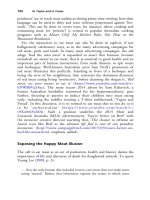The palgrave international handbook of a 247
Bạn đang xem bản rút gọn của tài liệu. Xem và tải ngay bản đầy đủ của tài liệu tại đây (39.8 KB, 1 trang )
242
J. Maher and T. Wyatt
harms evident in the wildlife trade. The techniques of neutralisation evident
among actors in both the legal and illegal trade reflect the complexity of
offender motivations and the multiplicity of factors influencing these.
Despite growing concerns and seemingly positive international political
will, particularly from consumer nations who often lead the political charge,
the wildlife trade continues to grow. Arguably, any attempt to reduce the
illegal trade and the associated suffering is compromised by a booming,
culturally legitimised trade, which involves wide-scale abuse of wildlife.
The current response is limited, partly due to existing loopholes in regulations and limitations in the political, enforcement and judicial response, but
also, and perhaps more importantly, it is our inability to reduce demand and
move beyond catching offenders to preventing the killing/capture in the first
place. What is urgently needed is a long-term strategy which might evoke a
sea change in attitudes towards the use and abuse of wildlife.
References
Beirne, P. (1999). For a nonspeciesiest criminology. Animal abuse as an object of
study. Criminology An interdisciplinary Journal, 37(1), 117–149.
Beirne, P. (2007). Animal rights, animal abuse and green criminology. In P. Beirne &
N. South (Eds.), Issues in green criminology: confronting harms against the environment, humanity and other animals (pp. 55–86). Cullompton: Willan Publishing.
Beirne, P. (2009). Confronting animal abuse: law, criminology, and human-animal
relationships. Maryland: Rowman & Littlefield Publishers.
Beirne, P., & South, N. (Eds.). (2007). Issues in green criminology: confronting harms
against environments, humanity and other animals. Devon: Willan Publishing.
Border Force. (2014). Smuggled iguanas returned home by border force. https://www.
gov.uk/government/news/smuggled-iguanas-returned-home-by-border-force.
Accessed 12 August 2015.
Cao, A., & Wyatt, T. (2013). The illegal wildlife trade in Vietnam. Asian Journal of
Criminology, 8(2), 129–142.
Coalition Against Wildlife Trafficking [CAWT] (n.d.). Illegal wildlife trade. http://
www.cawtglobal.org/wildlife-crime/. Accessed 6 July 2012.
Convention on the International Trade in Endangered Species of Wild Fauna and
Flora [CITES] (2015). The CITES species. />Accessed 28 April 2015.
CITES Secretariat (2013). Heads of UNODC and CITES urge wildlife and forest
offences to be treated as serious transnational organised crimes. />eng/news/pr/2013/20130423_CCPCJ.php. Accessed 14 October 2014.









